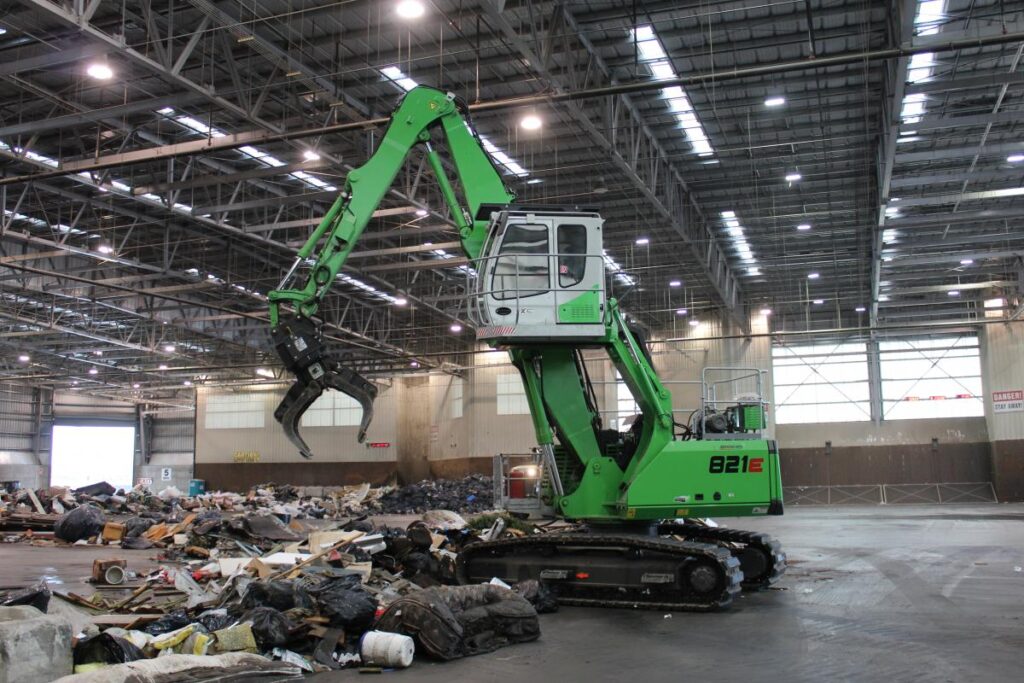Tacoma, WA – When Lewis Griffith comes into work these days, he gets to see first-hand the results of his previous job with the City of Tacoma.
Griffith is Assistant Division Manager responsible for onsite operations at the new transfer station operated by the City’s Solid Waste Utility. Before moving into this position, as a member of Tacoma’s Engineering Department, he was on the design team that developed this award-winning facility.
Part of the 190-acre Tacoma Recovery and Transfer Center, the new 83,000-square-foot transfer station, opened in the Fall of 2011. Handling 165,000 tons of garbage per year, the station achieves a vision of maximum flexibility, able to adapt to variable waste streams and traffic demands. The ultimate aim was to increase the volume of material diverted from the landfill into various recycling streams.
The City had set its sights on earning LEEDS certification, and was awarded LEEDS Gold standing for its efforts. SWANA (Solid Waste Association of North America) recognized the City’s effort with its Award of Excellence for 2013.
Purpose-built design
Near the same time Griffith took the reins to manage the facility, at the beginning of 2014, Griffith saw the operation take another big step toward its goal, with the commissioning of a new SENNEBOGEN 821 R-HD material handler.
Griffith explains, “We designed the facility with a material handler in mind. We gave it a large open floor to provide more room for sorting and recovery from the waste stream. The vision was to select loads that would have more of that type of recoverable material to be dumped on the floor here.”
Most of the material delivered to the transfer station is handled by wheel loaders, which push loads into the compactors for disposal in the landfill. The SENNEBOGEN machine is used to sort recyclable material and to pick out oversize items that are too large for the compactors.

Aided by the precision and flexibility of the 821 R-HD, the amount of material captured for recycling has doubled over 18 months.
“Ideal” for sorting waste streams
Mike Chapin is one of the division’s Heavy Equipment Operators who received training from SENNEBOGEN to run the 58,000 lb. purpose-built machine. After two-days of orientation on the new equipment, Chapin has been operating the 821 for about 60% of the day through his 10-hour shifts. Based on his 18 years at the controls of heavy equipment, he is pleased with the City’s choice for this application.
The grapple allows Chapin to pick through mixed loads of wood, metal and cardboards from commercial and consumer waste material. “We also have a top-load bay with a trailer parked below the tipping floor level to receive oversize items. The SENNEBOGEN is ideal for picking up those items and lowering them down into the trailer – that’s a 13 ft. drop – without damaging the walking floor. With the SENNEBOGEN, you can actually maneuver things around and set them in there really gently. [When] we get broken or rotten telephone poles, which we load into a trailer parked right on the tipping floor. Thanks to the hydraulic elevating cab, I’m up high enough to see right down into the semi-trailer, and I can articulate the logs any way I need to, to make a good load.”
Flexibility and safety
Along with the precision and versatility of the 821, Chapin appreciates the safety aspects of its design, as well. The machine’s square footprint gives it inherent stability, without requiring outriggers, to lift and move equal loads through 360o of swing. He also acknowledges the value of the two safety cameras (1x rear, 1x right side) provided as standard equipment on SENNEBOGEN machines.
Noting the open design and variable traffic flows in the station, he says, “They are a big help. There’s a fair bit of traffic… the area I’m working in is for the general public. We get anything from cars to pick-up trucks to dump trailers unloading garbage and construction debris here.”
Working under-roof, Chapin recalls some early concerns about potential damage to overhead electrical and sprinkler lines. These were quickly resolved with the installation of limit switches that keep the height and reach of the 821’s boom within safe limits. Chapin can override the switches, if needed, to complete a specific maneuver.
Improving capture of recyclable waste
Since the 821 arrived at the transfer station, Griffith and his team have continued to refine its recycling processes. Aided by the precision and flexibility of the 821, the volume of material captured for recycling from the waste stream handled in the transfer station has doubled over the past 18 months.
Lewis Griffith believes the City is on the right track. “There are so many varieties in the waste stream now; they have different characteristics and we now have opportunities to treat them differently. We didn’t know exactly how the material would move through the building; so we built for flexibility: a flat floor; no limiting walls or elevated areas, and multiple routes through different doors that let us change traffic lanes from weekdays to weekends.”
As the facility evolves, its use of the SENNEBOGEN 821 will evolve, too. “We’re looking for ways to have the material handler do the bulk sorting, and then do some hand sorting or put the material on the conveyor for some kind of further process. “That’s kind of in the future” Griffith concludes, “…looking at our options.”
